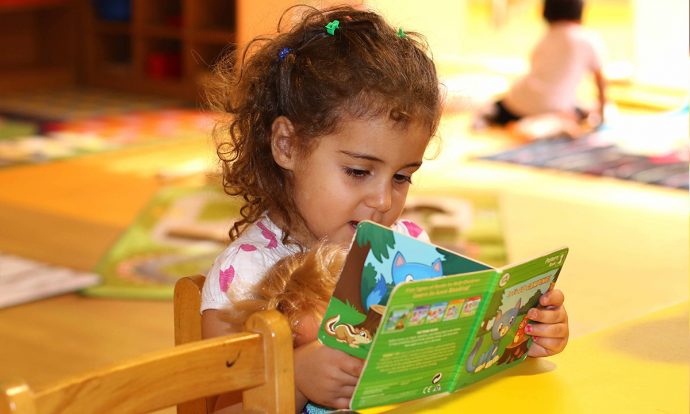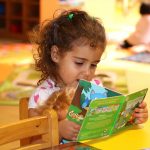-
Reading with your child is one of the most enjoyable and rewarding times you can spend together. Not only is reading together fun but it will increase your child’s language comprehension and vocabulary. In fact, studies show that the number of books a child has in his or her home prior to entering kindergarten is the number one indicator of a child’s later success in school.
Whether you have an infant, toddler, or preschooler, it’s never too early to start reading with your child. Even reading to very young children fosters early literacy skills and language development.
When selecting books to read with your child, here are some tips:
- Look for sturdy books that can withstand a young child’s constant handling and mouthing (board books with heavy cardboard pages are ideal for younger children).
- Choose books with words that are rhythmic to draw your child to the sounds of the story.
- Include books with interesting photos and illustrations.
- Include a few books that stimulate all the senses, such as touch-and-feel books or books that make sounds.
- Look for reputable authors and illustrators. Many classic children’s stories are also available in board book form.
- Include a variety of types of books, such as nursery rhyme anthologies with colorful illustrations, and nonfiction books such as illustrated cookbooks and science-themed books.
- Avoid books that represent popular TV shows or cartoon characters.
Easy, At-Home Literacy Activities
Now that you know what kinds of books to look for, there are a number of activities you and your child can do at home to help make reading a part of your daily routine.
- Read with your child every day.
- Model reading. When your child sees you reading newspapers, magazines, and books, he or she will see you value the activity and will want to read, too.
- Have books readily accessible for all of the children in your household.
- Have paper and writing tools such as crayons and pencils readily available for your child to scribble, draw, and write notes or lists. Scribbling and drawing are important precursors to developing writing skills. Read the same books repeatedly and help expand your child’s vocabulary. Children remember words they hear repeatedly and begin to use them in context. Most young children also enjoy re-reading familiar stories because they can participate in the storytelling process by sharing what they already know about the illustrations and story.
- Recognize and point out print, such as letters on signs while driving and labels in stores. Pointing out print in the world around us is one way to help children make the connection between letters and reading, and provides children with an informal way of interacting with letters and written words.
- Tell stories—real or pretend. Storytelling helps children develop vocabulary and language skills. It also boosts communication and conversation skills.
- Sing songs and recite nursery rhymes together. Singing helps children develop sound-awareness skills that are critical to successful reading. As children sing, they become aware of the sounds of language and the different ways sounds can be manipulated.
- Use everyday activities such as cooking to help children learn to follow simple written directions.
At the end of the day, making time to read together and making reading part of your family’s routine will help your child fall in love with reading and build important language and literacy skills that will benefit your child throughout his or her lifetime.
- About Us
- -- Our Approach to Education
- -- Accreditation
- -- Careers
- Curriculum
- -- Infants: 4 - 12 months
- -- Toddler: Under 2's
- -- Nursery: 2's to 3's
- -- Preschool: 3's to 4's
- Camps & Enrichment
- -- After School Care
- -- Enrichment Programmes
- -- Holiday Camps
- Our Nursery
- -- Meet the Staff
- -- Gallery
- -- Meals at Nursery
- Admissions
- -- Nursery Calendar
- -- Enrolment
- -- Refer a Friend
- For Parents
- -- FAQs
- -- How to Choose a Nursery
- Blog
- Book Tour




